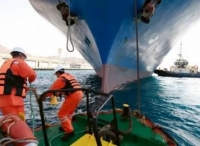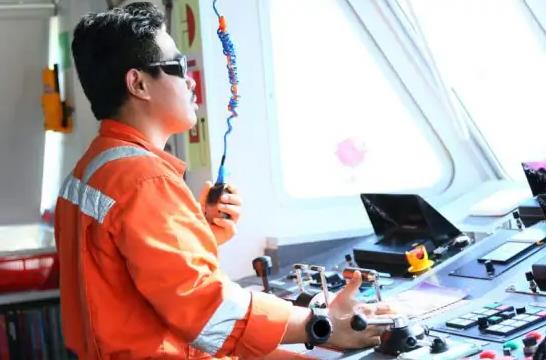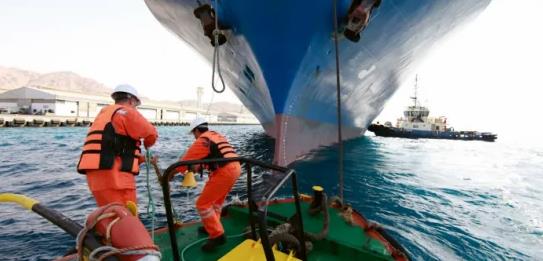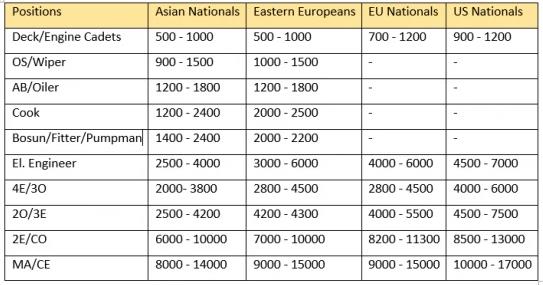如果你正在考虑一份航海职业,并选择研究它的优点和缺点,你会很快发现,高收入并不是所有航海专业人员都能保证的。你可以通过发展你的航海事业来提高你的收入,但有些海员面临着无法克服的歧视性问题,对此你无能为力。
If you are thinking about a career at sea and choose to study its advantages and deficiencies you will discover quickly enough that high earnings are not guaranteed to all maritime professionals. You can improve your earnings by developing your marine career, but some seamen face insurmountable discriminative issues one can do little about.
如今,谷歌推荐了大量文章,说明航运业中的性别工资差距;是当前的热门话题,;但我们想知道,海运业是否已经克服了基于国籍的薪酬歧视,从而如此自信地解决了另一个社会问题?
.
Today Google suggests tons of articles illustrating gender salary gaps in shipping; it is a hot topic at present; but we were wondering if the maritime industry have conquered a pay discrimination on the nationality ground to tackle another social problem so confidently?
Tendency to Discrimination
歧视倾向
事实证明,事实并非如此。来自不同国家的海员之间仍然存在巨大的薪酬差距。主要趋势如下:
As it turns out it has not. There are still some yawing pay gaps between seafarers from different countries. The key tendencies are as follows:
1、最高工资支付给在海上和石油天然气行业工作的美国和欧盟高级船员;
1.The highest wages are paid to the US and EU top officers working in the offshore and oil&gas industries;
2、非欧盟、印度和亚洲高级船员的工资是一致的。
2.Salary rates of non-EU, Indian and Asian officers are compatible.
3、收入歧视在较低级别中最为常见。例如,石油产品油轮上的亚洲甲板学员每月可获得400美元左右的报酬;而相同的工作,美国甲板学员则被承诺可获得950美元。
3.Earning discrimination is seen most in the lower ranks. For instance, Asian deck cadet on an oil product tanker can be paid around USD 400 per month; while US deck cadet is promised USD 950 for the same job.
4、就业方面也存在不平等。你几乎找不到任何欧洲海员愿意在化学品油轮上呆上9个月。同时,对于亚洲船员来说,这是一种典型的CoE状况,他们经常延长在船时间,不顾一切地想为家里的家人挣更多的钱。(小编:这里持保留态度,大家可以在评论区发表自己的意见)
4.Inequality can be found in the terms of employment as well. You can hardly find any European seafarer willing to stay onboard of a chemical tanker for 9 months. Meanwhile, this is a typical CoE’s condition for Asian crew who often prolong their trips desperate to earn more for their families at home.
5、在方便旗船上,美国和欧盟的普通船员几乎消失了;被更廉价、更宽松的亚洲和东欧劳动力挤出。
5.US an EU ratings are almost extinct under the flags of convenience; squeezed out by cheaper and more lenient Asian and Eastern European workforce.
这是一个范围,但让我们有条不紊地仔细看看数字,更是如此,因为航运业的情况似乎在最近的将来可能会发生变化。
This is a scope, but let us be methodic and look closely at figures, the more so because it looks like the situation in the shipping industry might change in the nearest future.
Crew Providing Nations
船员提供国
航运业并不是唯一容易出现种族工资差距问题的行业。2017,埃塞克斯大学社会与经济研究所在英国展开了广泛的研究。研究发现,如果出生在英国境外,男性没有机会获得与英国白人男性同等的收入。巴基斯坦和孟加拉国的情况尤其严峻。
“孟加拉国男性移民的收入差距最大为48%,这意味着他们的收入约为英国白人男性收入的一半。”有趣的是,这些国籍的人在海洋社区也是收入最低的。
The maritime industry isn’t uniquely prone to ethnicity pay gaps issue. In 2017 the Institute for Social and Economic Research, University of Es***, has unfolded a wide-scale research devoted to this topic in the UK. It has found that if born outside the UK, a man had no chance of equal earnings to White British men. The situation was particularly harsh for Pakistani and Bangladeshi.
“Male Bangladeshi immigrants experienced the largest pay gap of 48%, meaning they earned around half what White British men earned.” The interesting fact is that these nationalities are the least paid in the maritime community as well.
然而,让我们回到航运业的统计数字。根据ICS(国际航运协会),有5个主要船员国家(提供高级船员和普通船员):
However, let’s come back to the shipping industry statistics. According to ICS (International Chamber of Shipping), there are 5 main crewing countries (supplying both officers and ratings):
● 菲律宾(世界领先的普通船员输出国);
● The Philippines (the leading supplier of ratings in the world);
● 中国(世界上最大的高级船员输出国,普通船员输出排名第二)
● China (the biggest provider of officers in the world and 2nd by ratings supply);
● 印尼
● Indonesia;
● 俄罗斯联邦
● the Russian Federation;
● 乌克兰
● Ukraine.
* 要知道的是,世界上海员的总人数是1647500人;其中774000人是高级船员,873500人是普通船员。目前约有16500名高级船员短缺,而119000名普通船员供过于求。
* In case you were wondering the general number of seafarers in the world is 1,647,500; of which 774,000 are officers and 873,500 are ratings. At present there is a shortage of approx. 16500 officers and over supply of 119 000 ratings.
Salary Gaps’ Size
工资差距的大小
因此,海员主要由这五个国家的成员组成,但尽管他们占大多数,但他们没有制定规则。更深入一点你会发现,其他国家占据着更权威的职位,即利润丰厚的职位。
Therefore, seafarers’ community consists predominantly of these five nationalities, but despite being in majority they don’t lay down the rule. Look closer and you’ll discover other nationalities occupying more authoritative i.e. lucrative positions.
欧盟或美国船东的常见做法是:
The common practice for EU or US ship owners is:
● 把同胞放在前4位
● Place their compatriots on the top 4 positions;
● 由能干的东欧、印度或亚洲高级船员填补其余高级船员的空缺
● Fill the rest officers’ vacancies with able Eastern European, Indian or Asian officers;
● 相当***地削价,获得大量亚洲普通船员
● Undercut rather shamelessly and get plenty of Asian ratings.
每艘船舶的工资表由CBA(集体谈判协议)确定,但并非所有船东(慈善地说)都遵守该工资表。为了方便查阅,我们在Seaman Memories网站的帮助下编制了这些指示性工资表:
The salary scale for each vessel is defined by CBA (Collective Bargaining Agreement), but not all ship-owners (charitably speaking) adhere to it. We’ve compiled these indicative salary charts for your convenience with the help of Seaman Memories web portal:
Dry Cargo Ships, USD/per month
Dry Cargo Ships, USD/per month
数字很有说服力,但也有几个结论应该指出:
Figures are quite eloquent, but there are several conclusions that should be pointed put as well:
● 正如你所看到的,与其他群体相比,亚洲船员的起薪较低;然而,这种差别在高级职位中就不那么明显了。
● As you can see Asian crew have lower start wage rates compared to other groups; however, differences are less prominent with the more advanced job offers.
● 尽管薪资水平普遍存在重叠,但欧盟和美国官员的最高薪资水平仍然更高。
● Although there is a general overlap of wage rates, top rates of EU and US officers are still higher.
. ● 我们在之前的文章《SEAFARERS’ SALARIES: SCALE BY THE MARITIME-ZONE.COM》更紧密地研究了东欧的工资。
● We have studied Eastern European salaries in our previous article Seafarers’ Salaries: Scale by the Maritime-zone.com more closely.
● 对高层职位的专业知识和经验要求往往没有给种族偏好留下任何空间。然而,也有一些与安全相关的例外情况(例如,为了确保北海自升式平台附近的安全性,需要使用Masters -Norwegian扬声器)。
● Expertise and experience requirements for top positions often leave no room for ethnic preferences. However, there are might be some exceptions connected with safety (for example Masters -Norwegian speakers required to ensure enhanced safety near jack ups in the North Sea).
● 有特殊的规定,限制了可以在国旗下工作的国际船员数量;一些国家实施其他规定(培训、认证要求),限制外国船员的数量。
● There are special regulations that limit a number of international crew that can work under national flags; some countries impose other regulations (training, certification requirements) that limit a number of foreign crew.
● 英国海事和铁路工人工会(简称RMT)关注航运业的工资差距问题。如今,该法律将航运视为一种“特殊情况”,允许基于国籍的薪酬差异。2019年11月,政府提议取缔对英国国民和外国海员实行不同基本工资的做法。
● British RMT (national trade union covering maritime and railway workers) is concerned with salary gaps in maritime industry. Today the law treats shipping is as a ‘special case’ allowing nationality-based pay differentials. In November 2019 the government proposed to outlaw the practice of different basic rates for UK nationals and foreign seafarers.
历史证明,英国的立法活动往往成为其他国家的先例;这种做法首先在英国被采用,然后传播到世界其他地方。让我们希望航运界能够接受英国在平等工资方面的倡议,这样我们最终看到航运业的薪酬差距结束,成为真正的国际化企业。、
The history demonstrates that the UK legislation activity usually turns out to be a precedent for other countries; and practices first adopted in the United Kingdom then spread other the world. Let us hope that the maritime community picks up the British initiative over equal wage rates, so we finally see the end of salary gaps in the maritime industry and become truly international.
免责申明:本文来自MARITIME-ZONE,仅代表作者观点,不代表中国海员之家立场。其真实性及原创性未能得到中国海员之家证实,在此感谢原作者的辛苦创作,如转载涉及版权等问题,请作者与我们联系,我们将在第一时间处理,谢谢!联系邮箱:cnisu@54seaman.com






 联系我们人工客服
联系我们人工客服



















 :1391995811
:1391995811


评论 (0人参与)